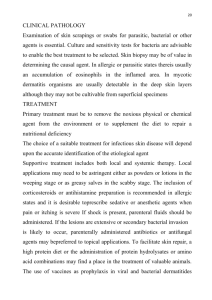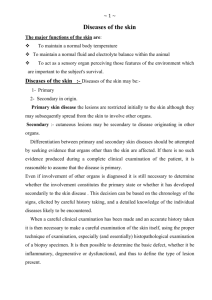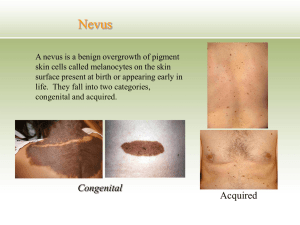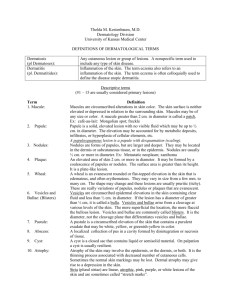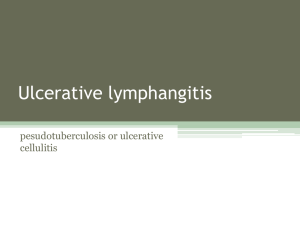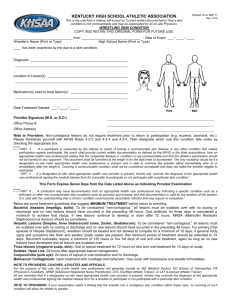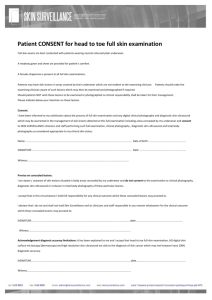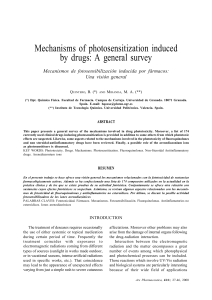Primary photosensitization
advertisement
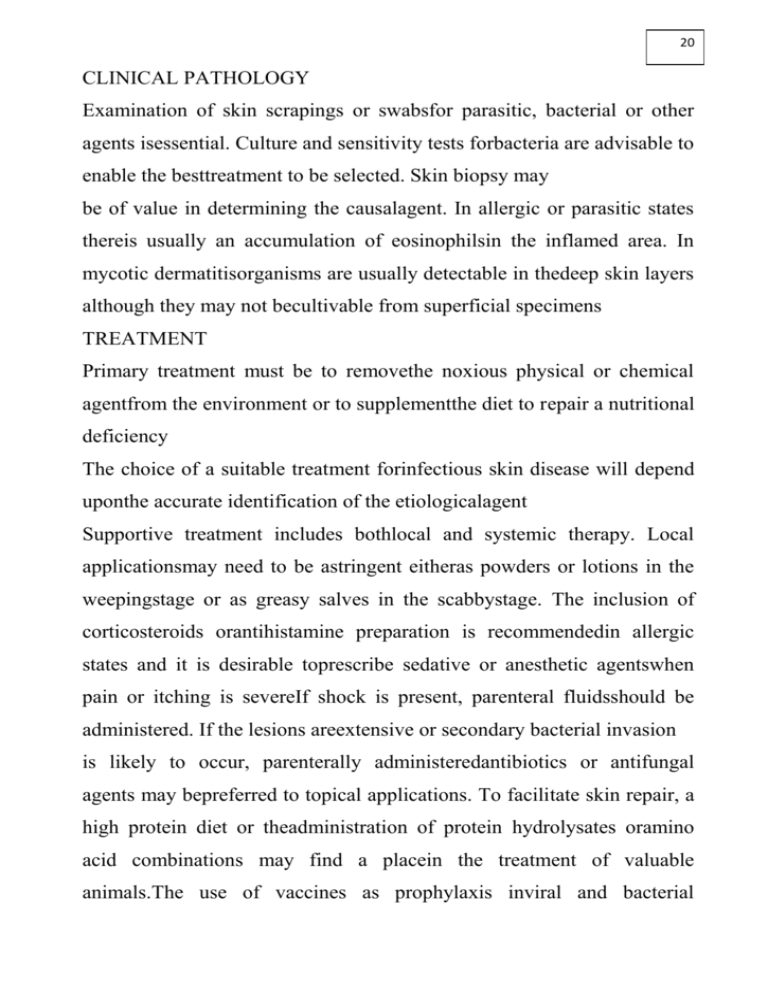
20 CLINICAL PATHOLOGY Examination of skin scrapings or swabsfor parasitic, bacterial or other agents isessential. Culture and sensitivity tests forbacteria are advisable to enable the besttreatment to be selected. Skin biopsy may be of value in determining the causalagent. In allergic or parasitic states thereis usually an accumulation of eosinophilsin the inflamed area. In mycotic dermatitisorganisms are usually detectable in thedeep skin layers although they may not becultivable from superficial specimens TREATMENT Primary treatment must be to removethe noxious physical or chemical agentfrom the environment or to supplementthe diet to repair a nutritional deficiency The choice of a suitable treatment forinfectious skin disease will depend uponthe accurate identification of the etiologicalagent Supportive treatment includes bothlocal and systemic therapy. Local applicationsmay need to be astringent eitheras powders or lotions in the weepingstage or as greasy salves in the scabbystage. The inclusion of corticosteroids orantihistamine preparation is recommendedin allergic states and it is desirable toprescribe sedative or anesthetic agentswhen pain or itching is severeIf shock is present, parenteral fluidsshould be administered. If the lesions areextensive or secondary bacterial invasion is likely to occur, parenterally administeredantibiotics or antifungal agents may bepreferred to topical applications. To facilitate skin repair, a high protein diet or theadministration of protein hydrolysates oramino acid combinations may find a placein the treatment of valuable animals.The use of vaccines as prophylaxis inviral and bacterial 21 dermatitidesmust notbe neglected. Autogenous vaccines maybe most satisfactory in bacterial infections. An autogenous vaccine is particularlyrecommended in the treatment of staphylococcal dermatitis in horses andbovine udder impetigo in which long andrepeated courses of treatment with penicillinproduce only temporary remission. An autogenous vaccine produces a cure inmany cases. PHOTOSENSITIZATION ETIOLOGY AND EPIDEMIOLOGY If photosensitizing substances (photodynamicagents) are present in sufficientconcentration in the skin, dermatitisoccurs when the skin is exposed to light. Photodynamic agents are substances thatare activated by light and may be ingestedpreformed (and cause primary photosensitization)or be products of abnormalmetabolism (and cause photosensitization due to aberrant synthesis of pigmentor be normal metabolic products thataccumulate in tissues because of faultyexcretion through the liver (and cause hepatogenous photosensitization) . Faulty excretion through the liver may be due tohepatitis, caused in most instances by poisonous plants, or to biliary obstructioncaused by crystal-associated cholangiohepatopathy, or rarely by cholangiohepatitisor biliary calculus. Primary photosensitization Photosensitization due to the ingestion ofexogenous photodynamic agents usuallyoccurs when the plant is in the lush greenstage and is growing rapidly. Livestockare affected within 4-5 days of going onto pasture and new cases cease soon afterthe animals are removed. In most casesthe plant responsible must be eaten inlarge amounts and will therefore 22 usuallybe found to be a dominant inhabitant ofthe pasture. All species of animals are affected by photodynamic agents, although susceptibility may vary between species and between animals of the same species. Photosensitizing substances that occurnaturally in plants include: Photosensitization due to a berrantpigment synthesis The only known example in domesticanimals is inherited congenital porphyria,in which there is an excessive productionin the body of porphyrins, which arephotodynamic. Hepatogenous photosensitization The photosensitizing substance is in allinstances phylloerythrin, a normal endproductof chlorophyll metabolism excretedin the bile. When biliary secretion isobstructed by hepatitis or biliary ductobstruction, phylloerythrin accumulatesin the body and may reach levels in the skin that make it sensitive to light. Although hepatogenous photosensitizationis more common in animals grazing grep.pasture, it can occur in animals fed entirely on hay or other stored feedsand in animals exposed to hepatotoxicchemicals e.g. carbon tetrachloride. There appears to be sufficient chlorophyll, or breakdown products of it, in storedfeed to produce critical tissue levelsof phylloerythrin in affected animals. The following list includes those substancesor plants that are common causesof hepatogenous photosensitization. The individual plants are discussed inmore detail in the section on poisonousplants. Plants contain inghepatotoxins Plants containing steroidal saponins Congenitally defective hepatic function 23 Photosensitization of uncertain etiology Clinical finding 1-General signs These commence with intense irritationand the animal rubs the affected parts,often lacerating the face by rubbing it inbushes. When the teats are affected thecow may kick at them and walk intoponds to immerse the teats in water, sometimesrocking backwards and forwards asif to cool the affected parts. In nursing ewes there may be resentment towards the lambs sucking, and heavy lamb mortalities due to starvation may result. Local edema is often severe and maycause drooping of the ears, closure of the eyelids and nostrils, causing dyspnea, and dysphagia due to swelling of the lips. Anearly sign is increased lacrimation, with the initially watery discharge developing into athicker, serous discharge accompanied by blepharospasm and swelling of the eyelids. Initial erythema of the muzzle is followedby fissuring, then sloughing of the thickskin. 2-Skin lesions Skin lesions are initially erythema, followedby edema and subsequently weepingwith matting then shedding of clumps ofhair, and finally gangrene. They have a characteristic distribution, restricted to the unpigmented areas of the skin and to thoseparts which are exposed to solar rays. Theyare most pronounced on the dorsum of thebody, diminishing in degree down the sidesand are absent from the ventral surface. The demarcation between lesions and normal skin is very clearcut, particularly in animalswith broken-colored coats. Predilection sites for lesions are theears, conjunctiva, causing opacity of the lateral aspect of the cornea, eyelids, muzzle,face, the lateral aspects of 24 the teats and, toa lesser extent, the vulva and perineum. Insolid black cattle dermatitis will be seen atthe lips of the vulva and on the edges ofthe eyelids, and on the cornea. Linearerosions often occur on the tip and sidesof the tongue in anin1als with unpigmentedoral mucosa. In severe cases the exudationand matting of the hair and local edemacauses closure of the eyelids and nostrils.In the late stages necrosis or dry gangreneof affected areas leads to sloughing oflarge areas of skin. 3-Systemic signs These include shock in the early stages,due to extensive tissue damage. There isan increase in the pulse rate with ataxiaand weakness. Subsequently a considerableelevation of temperature (41-42°C-106, °107F) may occur. 4-Nervous signsThese including ataxia, posterior paralysisand blindness; depression or excitementare often observed. A peculiar sensitivity to water is sometimes seen in sheep withfacial eczema: when driven through waterthey may lie down in it and have aconvulsion. 5-Liver insufficiency Signs are described elsewhere and may accompany photosensitive dermatitis when it is secondary to liver damage.
